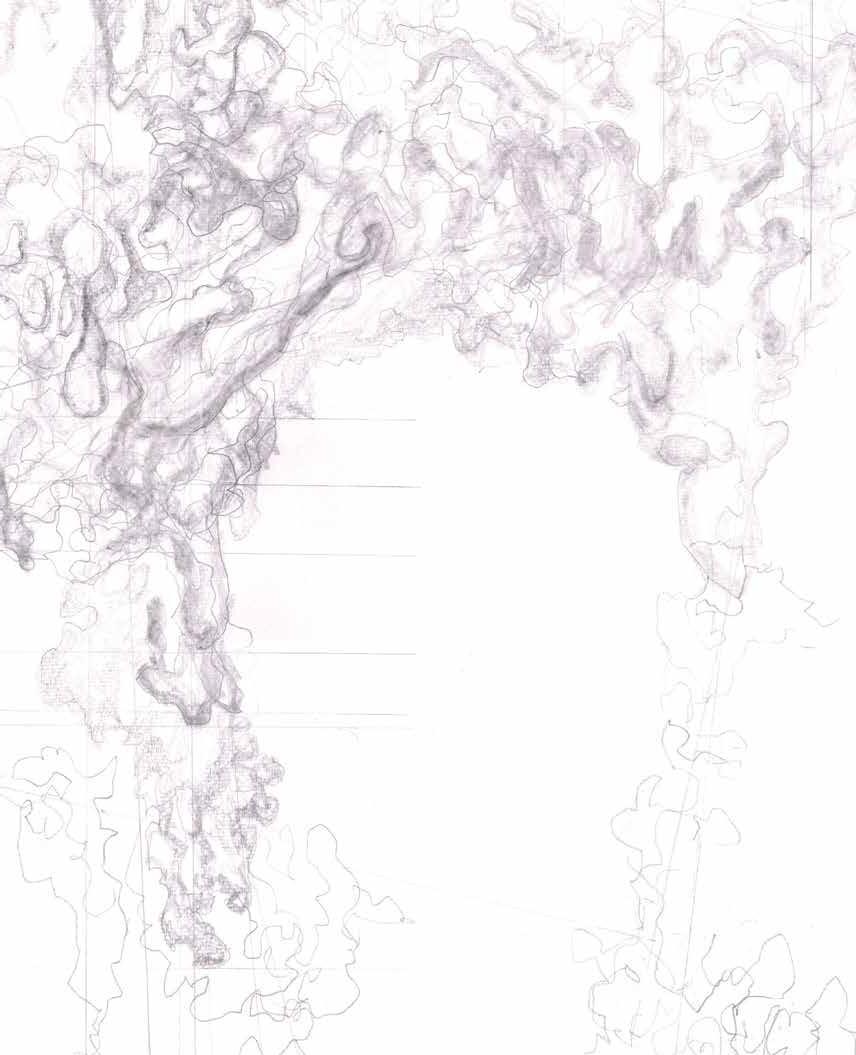
Master of Landscape Architecture ‘22 University of Virginia 949.573.1682 avgrospe@gmail.com 2023 Portfolio ANDRE GROSPE

2
James River Floodplain, 2021
CNC poplar
EDUCATION
Charlottesville, VA
2016 - 2020 2020 - 2022
WORK
Remote
November - present 2022
Minneapolis, MN
June - August 2022
Remote January - August 2021
Charlottesville, VA
May - August 2019
EXPERIENCE
Charlottesville, VA
Fall 2021
Spring 2022
UNIVERSITY OF VIRGINIA School of Architecture
B.S. Architecture with High Honors Master of Landscape Architecture
RESEARCH ASSISTANT, Proof Projects
In collaboration with The Nature Conservancy, Anchor QEA, and the Port of Baltimore, analyzed the mouth of the Patapsco River as a potential site for the beneficial reuse of dredged sediment. Established drawing standards, layouts, and a graphic language for a prospectus of the work.
INTERN, TEN x TEN
Researched and visualized the social life of South Minneapolis, a predominantly Black community displaced by the construction of I-35W. Created diagrams, base plans, and renders for a two-week memorial competition located in Waukesha, WI. Designed, modeled, and prototyped a repeating fence module for a ski resort in Vail, Co.
INTERN, Stoss Landscape Urbanism
Crafted diagrams, renders, animations, and other marketing material for over six different projects located across North America, including the Boston Urban Forest Plan, Edmonton’s Touch the Water Promenade, the Los Angeles Urban Forest Equity Streets Guidebook, and the Nantucket Coastal Resiliency Plan.
RESEARCH ASSISTANT, Somatic Collaborative
Assisted in the production of five models showcasing urban development patterns arising from resource extraction in South America. The models were slated for exhibition in the 2019 Chicago Architecture Biennial. Also produced over a dozen images for Collective Living and the Architectural Imaginary, a catalogue of 60 seminal housing projects around the world.
FABRICATION ASSISTANT | School of Architecture Fabrication Lab
Helped maintain a calm, clean, safe, and supportive space for fabrication and experimentation with woodworking tools, CNC routers, laser cutters, 3D printers, water jets, and more. Introduced and trained dozens of first-year graduate and undergraduate students in basic woodshop safety, from basic caliper and speed square use to table saw and bandsaw techniques. Designed and ran a stool making short course that taught students how to properly use a dado stacked table saw to create box joint connections.
Charlottesville, VA
Fall 2021
Present
Charlottesville, VA
Fall 2021
Charlottesville, VA
Fall 2018
Fall 2021
AWARDS
Spring 2020
Spring 2020
Spring 2019
Fall 2018
Fall 2018
2017 - 2020
2016 - 2019
SKILLS
EDITOR | LUNCH 17
Co-edited the 17th issue of the School of Architecture’s independent student journal. Helped curate and edit over 30 articles, visual essays, and art pieces dissecting and expanding the notion of craft in design.
TEACHING ASSISTANT, LAR 6020 | Foundation Studio I
Co-taught six workshops involving conceptual design, sketching, physical model making, 3D model making, and other essential skills to the incoming first-year MLA students.
TEACHING ASSISTANT, ARCH 1020 | Lessons in Making
Guided sections of first-year undergraduate students through the fundamental elements of architecture and design. Through five exercises and a final project, each student learned critical drawing, model making, and design thinking techniques.
FACULTY OF ARCHITECTURE AWARD FOR DESIGN EXCELLENCE
SEAN STEELE-NICHOLSON MEMORIAL AWARD
UVA ARTS COUNCIL DISTINGUISHED ARTIST AWARD IN ARCHITECTURE
INTERMEDIATE HONORS
RAVEN SOCIETY MEMBER
SELECTED STUDIO WORKS (Fall ’17, Spring ’18, Fall ’18, Spring ’19, Fall ’20)
DEAN’S LIST (Fall ‘16, Spring ‘17, Fall ’18, Spring ’19, Fall ‘19)
RHINO 6, 7 (with V-RAY, GRASSHOPPER)
AUTOCAD
ADOBE CREATIVE SUITE (PHOTOSHOP, INDESIGN, ILLUSTRATOR, AFTER EFFECTS) ARCGIS (PRO, ARCMAP) FABRICATION (WOODWORKING, CNC MACHINING, LASER CUTTING, 3D PRINTING )
3 ANDRE VICTOR GROSPE P: 949 573 1682 E: avgrospe@ gmail.com
Worms Eye View, 2020
Digital Drawing

4
CONTENTS
100 DAYS OF MAKING | Sanda Illiescu | 2022
UNDER THE ROCKS AND STONES | Charlottesville, VA | 2018
LA AFTER OIL | Los Angeles County | 2020
TEN x TEN | Minneapolis, MN | 2022
STOSS | Remote | 2021
Somatic Collaborative | Remote | 2020
PUNCTUATING DREDGE | Chesapeake Bay | Davis, Shivers, Cantrell
STAGING THE STREET | University of Virginia Campus | Meyer, Mitchell
THE GREEN IN BETWEEN | Venice, Italy | William Sherman, Ali
5
EXPERIMENTS + MAKING UNDERGRADUATE WORK RESEARCH + INTERNSHIPS GRADUATE WORK 6-9 10-11 DRAWING WATER | Brian Davis | 2021 12-15 16-17 22-31 14-15 18-19 32-37 20-21 38-45
DRAWING WATER | Experiments | Brian Davis
Water Table Experiments
The water table does not recreate real world conditions. Only after careful observation and representation through models, animations, and drawings can this device become a useful design tool.
The table is a place to simulate and play with the natural processes of sediment deposition, erosion, wave action, and delta formation. To communicate the aesthetic potential of these forces, we used rotoscoping, photogrammetry, and overlay to represent phenomena in novel yet still descriptive ways.

6
The table allows us to test formal ideas, like ditch patterning shown above, against the unpredictable dynamics of moving water. Because the final striations of sediment were produced by our constraints, we see these psuedo-landscapes as a loose kind of descriptive drawing.

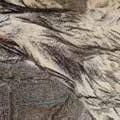




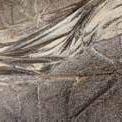






7
Untitled Sediment Drawing, 2021 Sediment, Water
Point Bars









Point bars are sediment deposits at the bends of rivers. While evident when simulated in the table, these formations take years to morph and grow, invisible to human perception. The drawing on the right is a palimpsest of the channel’s wavering thalweg and the accumulating landmass on the inside bend.














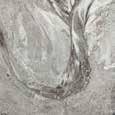












8
Untitled, 2021 graphite, ink on trace

9
The Ulm Stool
Max Bill was broke when he started the Ulm School of Design. Not even enough money for chairs. Thus his students’ first assign ment was to build their own portable stools. Its made of three boards connected by 34 box joints and a broom handle dowel for shear strength. Today, the stool is prohibitively expensive, but I still wanted one.

Over 100 days, I replicated and iterated on this simple design. Dialing in the jig was simple if not tedious. The challenge was finding wood. Within the school there is no shortage of awkward wood scraps and waste. The simple construction allowed me to use whatever I could find. Each of the 25 stools keeps the charac ter of the scrap that it came from.
Rubbings from a real Ulm stool, found at the German Pavilion in Venice (right)

10 100 DAYS OF MAKING | Sanda Illiescu

























11
25 Stools salvaged plywood, pine, ash, etc.
2021

12 UNDER
| Charlottesville, VA | Somers
THE ROCKS AND STONES
Site Model, 2019
water color paper, vellum, pins
This proposed addition to the University of Virginia supplements the Miller Center and its Democracy Initiative which pushes for an interdisciplinary study of the theory, implementation, and evolution of democratic systems. To understand how the architecture accomplishes this goal, it is first important to realize that this democracy center is not the center of democracy. It is not where world leaders, make, and execute decisions. It is, rather, a place for those who write, theorize, and implement democracy at both the official and civilian level to learn, debate, and challenge their practices in the hopes of finding a better way forward.
















13
Oil and Water
Overshadowed by more glamourous identities, it is easy to forget that Los Angeles is also an oil city. Since the early 20th century, over 30,000 oil rigs have embedded themselves in the city. Despite the destruction of communities and ecologies, the oil industry persisted and expanded.

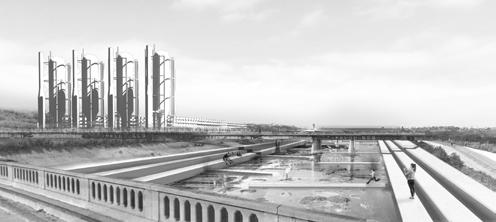
With the end of active oil drilling an environmental necessity, this thesis strives to find a purpose for these disparate sites. Inspired by the ways in which the spatial logic of the city accepts and sometimes benefits from the presence of oil infrastructures, this thesis speculates what an infrastructure water collection and purification looks like when subjected to the same game-like spatial logic of the city.
The Ballona Wetlands, the terminus of a bygone network of wet meadows, vernal pools, and fresh and salt marshes around Baldwin Hills, is now bound by highways, channels, and natural gas infrastructure. It is an ideal test site, allowing the project to wrangle this forgotten California ecology back into the logic of urban property that defines Los Angeles’ urban structure.

14 LA AFTER OIL | Los Angeles County | Mona El Khafif
(above top to bottom)
Top producing oil fields in LA County
View of water purification along Ballona Wetlands Within water purification pods
The 1x1 mile grid creates a framework to analyze and speculate the concieved and emergent consequences of these new infrastructures.

15
Ballona Wetland Tiles, 2020 concrete, basswood, brass
In two weeks, designed and prototyped a modular steel privacy screen for a ski resort in Vail, CO. The design takes inspiration from the criss crossing ski trails and the Tyrolean ornamentation found on older ski lodges in the area. The tightly spaced perforations afford privacy, camouflaging the adjacent rooms amongst the aspen forest.


16 INTERNSHIP | TEN X TEN | Minneapolis, MN
Section and Construction Details
Waterjet-cut Test Model
Photo credit: Ariana Arenius
Test Collages





17
Patter finding methods and alternate patterns
challenges and benefits of planting in certain areas. It also shows how planting can coincide with better pedestrian infrastructure. The selected spreads



18
INTERNSHIP | STOSS | Remote
Images from the LA Urban Forest Equity Streets Guidebook done with City Trees. The renders, diagrams, and sections show the
(left) were done by Davi Parente Schoen and graphics team at CAPA Strategies.


19



20
Somatic
Remote topography Exploded Axonometric of the Southern California Megaregion Layers urban area road water
US MEGAREGION RESEARCH |
Collaborative |
Summer research assistantship with Felipe Correa and Devin Dobrowolski analyzing the contemporary impact of the US Rectangular Survey System which dates back to the country’s founding. The work spans from large scale visualizations of the country and its history to a close analysis of each of the 50 states and their infrastructure’s adherence and adaptations to the Jeffersonian Grid. This exercise in rigorous cartography emphasizes how the simple layering and processing of publicly accessible datasets can weave a powerful story of our nation’s history of land acquisition and management.



















































PUNCTUATING
DREDGE | Chesapeake Bay | Davis, Shivers, Cantrell

All work was produced collaboration with Judy Chen and Ailsa Thai

Existing protection and containment measures for dredge are crude and unsightly. Facilities like Craney and Poplar rely on isolation and armory. These islands are both literal, surrounded by water, and metaphorical, separating themselves from the natural processes of the bay.
Using existing technologies of turbidity curtains, fences, and pumping equipment, this project seeks to punctuate this process of beneficial reuse, calling to attention the aesthetic potential of island building.
22
Doctored aerial of Barren Island showing deployed sediment curtains. Drawing by Ailsa Thai
The Chesapeake Bay is remarkably shallow. Many “disappearing islands” are submerged by less than ten feet of water. This is the same effective depth for sediment curtains and fences. The orange area corresponds to potential deployment sites.

Barren Island is one such island. The curtains’ deploymnet is choreographed over a ten year period, allowing sediment to gather at its base before shifting to expand the newly consolidated shallow landmass.

23
Barren Island zoom in plan by Ailsa Thai Mid Bay Shallow Zone map by Judy Chen and Andre Grospe
Consolidation Studies
water, sand mix, burlap, rock, nails, gauze, plywood, foamcore



While most forms of dredge containment are solid, the group was interested in a more leaky approach. We focused on what kind of material (pebbles, sand, or silt) passed through or accumulated against the screen.

24
Tools and Experiments






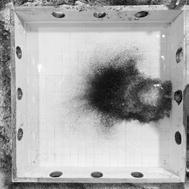



In order to understand how a sediment slurry accumulates and consolidates, the group used the water table alongside several custom observation devices like the plywood pump box above. The holes allowed sediment to be pumped from various angles while the foam core inserts could test the stopping power of different materials.


25
Diagrams by Ailsa Thai
Curtains and Fences




From the previous tests, we concluded that a semi-permeable fabric would best hold the sediment while also being a completely temporary solution. In shallow areas, the fabric would be deployed as a fence, while in deeper areas, they would be suspended as a sediment curtain. The tests above examines the repeated effect of wave action and sediment accumulation against different angles and layering of these systems.






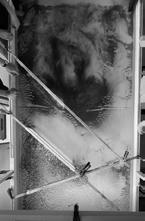

26
1:1 Construction Drawings

In order to convey the shallowness of the nearshore, the group toook care to draw the interventions at a 1:1 scale and presented them as such. A mockup of the sediment curtain was made to further convey the true scale of these devices usually submerged in murkey water.

27
Sediment Fence (left) Sediment Curtain (right) digital drawing
Fence drawing by Ailsa Thai Curtain drawing by Andre Grospe
Choreography
Curtain and fence deployment follow typical marine construction standards. Dredge placement also relies on existing thin layer placement techniques albeit in an unorthodox fashion. The innovation lies in the movement of equipment after wave action has pushed and consolidated sediment into a more stable position.


28
1. Curtains are assembled on shore and towed into place and deployed with the help of shallow draft boats
2. Dredge boats loaded with slurry anchor at a safe depth. Floating docks help support and direct the spray of material.







29
Stage 0: Before placement
Stage 3: Further growth and consolidation.
Stage 1: Initial curtain and sediment placement
Stage 4: Curtain movement and further placement.
Stage 2: Sediment movement and growth
Stage 5: Consolidation. Land is built and technique is switched to silt fences.
Exhibition
Sketch Wall with collages, pastel drawings, and wave simulations by Judy Chen, Andre Grospe, and Ailsa Thai

1:1 Section Details by Andre Grospe, and Ailsa Thai
Mock Sediment Curtain made of custom water jet hardware, ripstock nylon, geotextile fabric, stainless shackles, foam by Andre Grospe
Digital Presentation
Prospective Aerials and Perspectives
pastel, pencil, collage by Ailsa Thai
The group’s studies spanned from collages, sketches, videos, overlays, and mapping. This breadth was presented as an interactive exhibit in order to invite guests into our process. The goal was to convey both the plausability of the intervention and the aesthetic potential of these mysterious lines and mounds emerging from the water.
30
Predicted Sediment Movement Drawing
digital drawings traced and animated from experiments drawings and animations by Andre Grospe
Section Development over time
digital drawing and collage by Judy Chen
Deployment Schedule (above) and Installation Plans and Vignettes (below) digital drawings, pastel overlay, collage by Ailsa Thai and Andre Grospe

Barren Island Plan
digital drawing by Ailsa Thai
Light Box with alternate sites
digital drawings on vellum box by Andre Grospe drawings by Ailsa Thai and Judy Chen
Mid Bay Shallows Map
digital drawing by Judy Chen and Andre Grospe
31





32
STAGING THE STREET | University of Virginia Campus | Meyer, Mitchell
Site Plan with significant axes
Canopy Study Model
Racialized Topographies



Currently, the Black Bus Stop is a 50’ x 50’ UTS bus stop located at a middle ground, both in plan and section, on the South Western edge of the Lawn, at the base of the former plantation Monroe Hill. However, this seemingly banal point within the University proved a significant space for Black visibility and gathering during the 70s-00s, serving as both everyday meeting place and stage for initiation and celebration events, all in the informal confines of a bus stop.
This project takes inspiration from the ways in which a critical mass can transform a space of transience to a place of joy and conviviality. By expanding the paving from the sidewalk, across the road, the bus stop further asserts itself as a space for pedestrians rather than traffic. The built canopy and planting help turn this space into an outdoor room.
33
Paving Plan
Plan
Canopy

34 Defining Ridgeline



35
Topography, Hydrology, and Urban Morphology of Charlottesville
Urban Figure
Lowland Figure
Thick Sections
University of Virginia planned its architecture to displace, segregate, and hide Black communities. These communities found home in the lowest lying areas of the city, the only land available to them. The Black Bus Stop exists at the juncture of this racialized topography. The ridge the BBS sits upon was a contact zone between students and enslaved laborers. The drawing above reveals the thick and erased history embedded in the land.


36
The thick section drawing helped clarify the form of the design. The retaining walls push land back to form a stage that rests on a ridge. This gives the BBS a topographic presence at the end of this ridge.

37
Sketch Model, 2021
basswood, mesh, cardstock, thread




38
Plastecine Study Models (above)




39
THE GREEN IN BETWEEN | Venice, Italy | William Sherman, Ali Fard
All work was produced collaboration with Ailsa Thai
The walk from mainland Italy to Venice is a delirious, monotonous, and poetic 2 mile walk. Crossing the bridge is often the closest one gets to the lagoon, though one rarely notices. Over the edge, oysters, fish, and crabs dwell in riprap and seagrass. The walk gives time to speculate the inevitable changes coming to Venice. On one end of the horizon, one sees a dying industrial site and on the other, a city trapped in time. Both threatened by sea level rise and decay.
Inspired by our daydreams during this walk, this project reveals the bridge as critical joint between Mestre and Venice. We imagine a bridge without cars, oriented towards pedestrian mobility. The bridge acts like a warm-up to a city where walking is the only sensible way to navigate.

Embracing and amplifying its proximity to the water, the project subtracts paving to make space for spontaneous vegetation to take over, while also adding elevated pathways that allow one to explore spaces above, below, and between this often ignored Venetian infrastructure.
Venice from the Bridge (above, right)
Study models for grooving patterns (below, right)





Spontaneous vegetation in Venice (opposite, full spread)

40









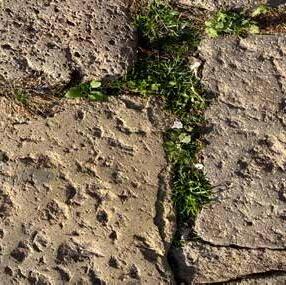


Urban Sketching
During our six week stay in Venice, sketching became the primary way of record keeping. Of particular interest to us were the details both old and new. The joint work of Carlo Scarpa, corner details of Palladio, and historical palimpsests of Codussi keyed us into the Venetian mindset. This was critical in attempting to weave the bridge into the city’s urban fabric.




42




43
Selection of sketches by Andre Grospe
Most only experience this bridge through the window of a train or car. The journey lasts less than five minutes. The walkway is for those wanting a slow experience full of distractions.





We deconstruct the street with existing surface groovers, allowing spontaneous vegetation to thrive. The elevated walkway still allows cyclists and joggers to speed across the bridge. But the more adventurous can always step off to stick their nose amongst the weeds and rocks.


44
Walkway Exploded Axon (above, right)
Study models of sections of the bridge (above, below) Section, plan, elevation, and axon of walkway and floating dock (opposite)
There are no shortages of sneaky paths in and around the city. Behind the Arsenale on the northeastern edge of the island is a precarious walkway. We found this by accident. The walkway contorted around portals and walls of the city like it was avoiding capture. Less than twenty feet from the edge, we could spot the mud flats that undergird the city. The excitement of that proximity inspired us to give access to the inaccessible.

How do you convey the daydreams that flood your mind on a long walk? We used an accordion book with a drawing and aerial of the bridge on either side. This allowed us to parse the bridge


46
Accordion


47





















































































































































































































































































